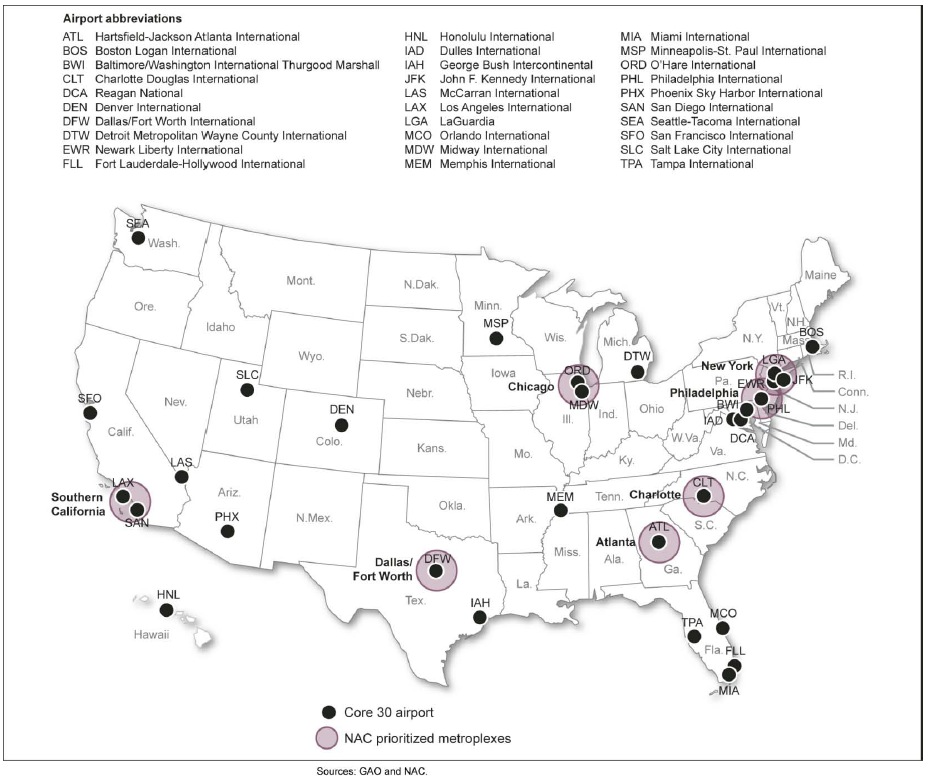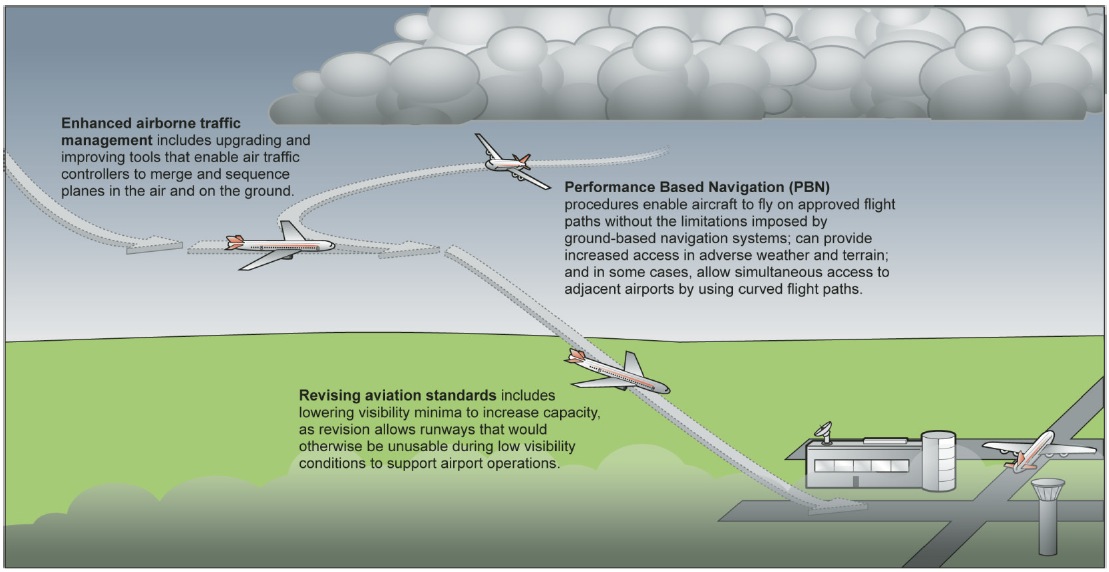UNITED STATES GOVERNMENT ACCOUNTABILITY OFFICE
What GAO Found
 The Federal Aviation Administration (FAA) is pursuing key operational improvements to implement the Next Generation Air Transportation System (NextGen) in the “midterm,” which is 2013 through 2018. These improvements focus on establishing Performance Based Navigation (PBN) procedures at key airports, but benefits could be limited in the midterm. PBN uses satellite-based guidance to improve air-traffic control routes (known as “procedures”). These procedures can deliver benefits to airlines, such as fuel savings and increased efficiency, particularly in congested airspace. To deliver benefits more quickly, FAA made trade-offs in selecting sites and in the scope of proposed improvements. For example, FAA is not implementing procedures that will trigger lengthy environmental reviews. These trade-offs, with which airlines and other stakeholders generally agree, will likely limit benefits from these PBN initiatives early in the midterm. FAA has also made some progress in other key operational improvement areas, such as upgrading traffic management systems and revising standards to improve aircraft flow in congested airspace. However, FAA has not fully integrated implementation of all of its operational improvement efforts at airports. Because of the interdependency of improvements, their limited integration could also limit benefits in the midterm.
The Federal Aviation Administration (FAA) is pursuing key operational improvements to implement the Next Generation Air Transportation System (NextGen) in the “midterm,” which is 2013 through 2018. These improvements focus on establishing Performance Based Navigation (PBN) procedures at key airports, but benefits could be limited in the midterm. PBN uses satellite-based guidance to improve air-traffic control routes (known as “procedures”). These procedures can deliver benefits to airlines, such as fuel savings and increased efficiency, particularly in congested airspace. To deliver benefits more quickly, FAA made trade-offs in selecting sites and in the scope of proposed improvements. For example, FAA is not implementing procedures that will trigger lengthy environmental reviews. These trade-offs, with which airlines and other stakeholders generally agree, will likely limit benefits from these PBN initiatives early in the midterm. FAA has also made some progress in other key operational improvement areas, such as upgrading traffic management systems and revising standards to improve aircraft flow in congested airspace. However, FAA has not fully integrated implementation of all of its operational improvement efforts at airports. Because of the interdependency of improvements, their limited integration could also limit benefits in the midterm.
FAA has efforts under way to help overcome overarching obstacles to NextGen implementation identified by an advisory task force, but challenges remain, and many of these efforts are scheduled to take a number of years. FAA efforts include, for example, a new process for focused and concise environmental reviews for some proposed actions (e.g., new procedures), where a detailed analysis of the environmental impacts is limited to only those categories involving potentially significant impacts, such as increased noise or emissions. Some of these efforts do not, however, fully address previously identified obstacles. FAA has not fully addressed obstacles to selecting new PBN procedures that will best relieve congestion and improve efficiency, for example. FAA continues to rely on requests for new procedures from airlines and other stakeholders. This reliance may or may not result in procedures that maximize benefits to the national airspace system. Not addressing remaining challenges could delay NextGen implementation and limit potential benefits.
FAA has made progress in developing NextGen performance metrics, but according to key stakeholders, FAA currently provides limited data to demonstrate its progress in implementing midterm improvements and the associated benefits. FAA is in the process of harmonizing performance metrics across all agency programs to ensure that metrics align with agency targets and goals. However, information is incomplete on the midterm improvements and their benefits at selected airports, and airlines and others lack access to needed information to make fully informed investment decisions. FAA has developed a website to report on NextGen implementation, but published information is not fully tied to FAA’s implementation goals. FAA’s plans also provide limited information about future implementation, such as locations and expected benefits. Better performance and planning information would provide airlines with a stronger basis for making decisions to invest an estimated $6.6 billion on NextGen technology through 2018.
Download full report (PDF): NextGen Air Transportation System
About the Government Accountability Office (GAO)
www.gao.gov
“The U.S. Government Accountability Office (GAO) is an independent, nonpartisan agency that works for Congress. Often called the “congressional watchdog,” GAO investigates how the federal government spends taxpayer dollars. The head of GAO, the Comptroller General of the United States, is appointed to a 15-year term by the President from a slate of candidates Congress proposes. Gene L. Dodaro became the eighth Comptroller General of the United States and head of the U.S. Government Accountability Office (GAO) on December 22, 2010, when he was confirmed by the United States Senate. He was nominated by President Obama in September of 2010 and had been serving as Acting Comptroller General since March of 2008.”
Tags: GAO, NextGen Air Transportation System, United States Government Accountability Office







 RSS Feed
RSS Feed